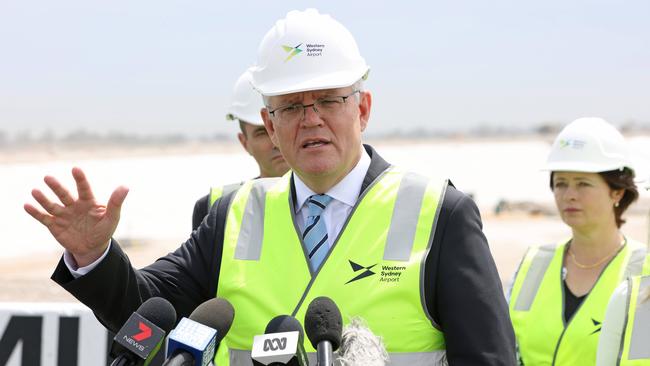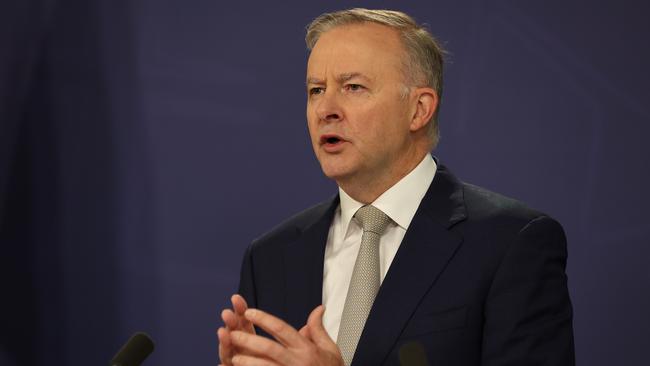Election road is all goat tracks and highways
While there are many ways to hypothesise the path to a Labor election victory, the reality is that they are all goat tracks.

Just over 12 months earlier, the then opposition leader had met Arnold Schwarzenegger at a charity event and a hot mic recorded him telling the Hollywood star: “I’m going to be Australia’s next prime minister.”
While hubris is an obvious takeout from these examples, so is the reality that predicting election outcomes is fraught with danger. Having telegraphed in no uncertain terms that I thought Shorten had the 2019 election in the bag, I’m throwing stones from a rather brittle glass house.
The freeway/goat track analogy has a place when plotting likely outcomes at the next federal election, but the comparison is different to Shorten’s overconfident summary.
Morrison is arguably the favourite, despite his clamouring for underdog status this week. Why? Because while there are many and varied ways to hypothesise a Labor victory, they are all goat tracks.
By contrast, there is only one way that Morrison and the Coalition wins – a single-lane highway as straight as the one across the Nullarbor Plain.
The Prime Minister has no room for error. He must shift the focus to the economy, and he can’t then lose that debate on the economy. Veer off course and this government has little else to fall back on. Pandemic management is in the rear-view mirror, and the extent to which it matters is only in the context of post-pandemic recovery: an economic debate.
Labor has a dozen goat tracks that take it to victory: question marks over the PM’s honesty; vaccine rollout failures; gender problems; too many high-profile and marginal-seat retirements; a unique electoral problem in Western Australia; weaknesses on climate and emissions policies; no clarity on the implementation of a federal watchdog; government fatigue after three terms in power; independent challenges in moderate Liberal-held electorates; and a growing trust deficit that is starting to eat into the Prime Minister’s personal polling numbers at the same time as the Coalition trails on the two-party vote.
It is quite a list but it remains unclear whether mainstream Australia fixates sufficiently on any of these Coalition weaknesses for long enough to change votes. They are goat tracks one and all.
Perhaps the most potent factor in Labor’s favour is the combination of the polling lead it still has (six points) and the dwindling personal support for Morrison. In the latest Newspoll, his “better PM” lead over Anthony Albanese fell from 14 points to eight – assuming that published opinion polls are reflecting the more accurate internal party track polling, which probably isn’t under way yet in any meaningful way.

By contrast, the Coalition knows exactly what it has to do at both the macro and micro levels: focus the discussion on the economy and sandbag key seats, while going after enough Labor pick-ups to overcome losses that can’t be prevented.
Another goat track for Labor which closer to polling day could become a fully redeveloped super highway is if voters just turn Morrison’s pitch into white noise. That is, if the case for electing Labor becomes immaterial because people are sick of this government.
That’s what happened in 2013 when Australians elected their least favourite opposition leader, Tony Abbott. Abbott and his team get political credit for their relentless attacks on Labor under both Julia Gillard and Kevin Rudd, helping to expose what it was that voters decided was irredeemable about their governments.
Abbott’s unpopularity didn’t matter. Question marks about what sort of government he might lead didn’t matter. Voters wanted Labor out and they voted against them in droves.
Are we seeing such signs now for the Coalition? Not in the mainstream, I would suggest.
There is dissatisfaction, no doubt. But closed minds ready to vote the government out? Not yet, and perhaps not ever.
The old adage is that governments win the close elections, oppositions win with blowouts. Largely, this is true, other than the fact that when Labor does win, the majority tends to be smaller than expected. That was the case for Gough Whitlam in 1972, and again for Rudd in 2007. Less so when Labor came into office in 1983 under Bob Hawke – the election that a drover’s dog could have won, according to a bitter Bill Hayden shortly after being forced aside as Labor leader to make way for Hawke.
Those are the only three times Labor has come to power since World War II, not a great track record. Which also feeds into the Coalition’s favouritism despite all of its problems.
On two of the three occasions Labor has won its way into government from opposition over the past 70-plus years, it did so with an “it’s time” theme built of seemingly bold promises.
Whitlam promised major social order change, and Rudd was committed to climate change action and apologising to Indigenous Australians. Granted there was more substance and breadth to Whitlam’s agenda, but both leaders sought emotional appeals.
The Hawke victory was more about booting Malcolm Fraser out of office, off the back of high unemployment, rising debt and recession. With no pandemic to blame.
Ironically, Hawke’s was the most successful of the three Labor governments. More ironically still, this was on the issue of economic reform.
We don’t yet know whether there are any policy fronts on which Labor will go big when campaigning at the election. So far what has been revealed is more about feeding into minor differences with the government – the aim being to contrast the worst of Morrison and his administration, but without scaring voters about the alternative.
The 2019 election was defined by Labor’s big-target agenda and Morrison’s capacity to attack it, as well as an opposition led by someone who never captured the imagination of voters. The Coalition found the right leader for the times eight months out from polling day. Malcolm Turnbull was too complex for a simple scare campaign and simple messaging. No such problem for his replacement. Morrison’s simplicity – a vice in government – became a virtue when campaigning.
Will history repeat itself? With so much having changed over the past three years, it is possible that all the change around us will not change what people ultimately do in the privacy of the ballot booth.
Peter van Onselen is political editor at the Ten Network and a professor of politics and public policy at the University of Western Australia and Griffith University.





“Our pathway to victory is a freeway, theirs is a goat track.” Labor’s Bill Shorten uttered those words to assembled journalists one week out from the 2019 election he went on to unexpectedly lose to Scott Morrison and the Coalition.